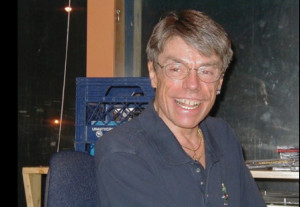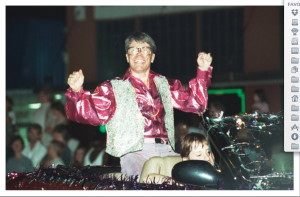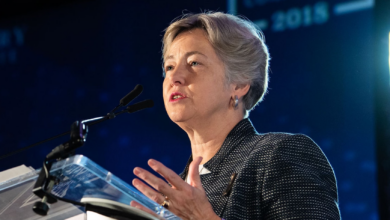
One Last Broadcast: Jimmy Carper, radio voice of Houston’s LGBT community, dies at 66
One Last Broadcast: Jimmy Carper, radio voice of Houston’s LGBT community, dies at 66
by Rich Arenschieldt
As I’m drifting off to sleep, the phone rings. I stumble to answer it, wondering which of my friends needs bail money. I hear a chirpy voice on the other end. “Rich, it’s Jimmy Carper with KPFT’s After Hours—I’ve had a guest cancel at the last minute, so can you come over to the station and fill in?” I throw on a pair of jeans and minutes later am giving listeners an update on the latest HIV treatment news. This late-night ritual solidified my acquaintance with Jimmy: he needed a guest, my nonprofit needed airtime. When we saw each other after that, he always joked, “Rich can go from his bed to my broadcast booth in 20 minutes.”
with Jimmy: he needed a guest, my nonprofit needed airtime. When we saw each other after that, he always joked, “Rich can go from his bed to my broadcast booth in 20 minutes.”
Carper, a regional LGBT broadcasting institution, died on January 27, 2014, after living with HIV for almost 30 years. His involvement with KPFT’s After Hours was the largest diamond in his tiara, but not his only memorable accomplishment.
“From his early days, Jimmy was a standout—unique in almost every way,” recalls Nancy Carper-Hall, Jimmy’s sister. “He and I were 15 years apart. Our family was most proud of his academic abilities. He was a very gifted student, described by family members as ‘brilliant.’ He loved music and was a marvelous accordion player, entirely self-taught. He was also intensely interested in the arts, especially theater.” They grew up in New Jersey, where Jimmy attended Roxbury High School in Succasunna. He later attended the University of Houston.
According to his sister, Jimmy’s home life was challenging. “Our mother was coping with severe mental illness while we were growing up. Jimmy, being the eldest, was her primary caregiver. Because of this, he essentially raised our entire family. Caring for our mother was extremely difficult and, unfortunately, Jimmy bore the brunt of managing her illness.”
Jimmy came out to his family in the mid-’60s, something almost unheard of for an eldest son of a small-town Irish Catholic family. “This was not accepted by my parents,” Carper-Hall says. “Jimmy, being who he was, could only be true to himself. It was necessary for him to distance himself from us in order to survive. He did the only thing he could—at age 18, he left home and moved to New York City. He left home and never looked back. After that, the subject of his sexuality was never discussed.”
The siblings lost touch with each other and then reconnected when Jimmy’s sister (also gay) left home for college. “We had written to one another and were aware of what was happening in each other’s lives.” Then, years later, with the help of the After Hours producers, the two spoke for the first time, on air. “The first time I talked with Jimmy was on the radio program in the 1980s. He and I spoke for a while. It was simultaneously exciting, surreal, and a bit bizarre.” The two had an innate understanding of each other, both having endured a very difficult upbringing. When Carper-Hall came out to her family years later, things had changed significantly. “My father actually walked me down the aisle with my current partner of 21 years—something that never could have happened for Jimmy. My father realized what he had lost as the result of the way Jimmy had been treated.
“Jimmy was always ‘out there,’ forever willing to raise the flag and never fearful of what might happen. I realized that Jimmy paved the way for me. My life was so much easier because of him. He, in essence, paid the price for both of us, something for which I will always be grateful.”
Most people knew Jimmy as a result of his 25 years at the helm of After Hours, KPFT’s LGBT radio program. Conceived by Founding Executive Producer Buddy Johnston, the show first aired in the fall of 1987. “I received permission from KPFT’s [current general manager] Duane Bradley to do the program. Jimmy was in the studio from the beginning,” Johnston remembers. “Originally, Jimmy answered the phones, and after a few months he joined me on the air. Jimmy referred to himself as the ‘Gay Ed McMahon.’ Jimmy interviewed guests, rustled up volunteers and pledges, and was always corralling everyone who was running around in the lobby.
“Jimmy knew what I was going to say before I said it; we had a wonderful rapport. He was always thinking of ways to push the envelope. The two of us did crazy things on the air. We would call the White House in the middle of the night, asking to speak with President Reagan about the AIDS epidemic. Back in the ’80s, when the ‘976’ sex lines were popular, we would call and interview men who were cruising there. Often, the most hilarious things would happen spontaneously, when he and I were just talking with each other. In many ways Jimmy was the life and breath of the endeavor.”
Listeners responded to that freewheeling style in kind. “I have a stack of letters we received, many from younger listeners, who sincerely appreciated our efforts. In those days there were no positive gay role models; people often listened to the show secretly,” Johnston recalls.
Judy Reeves, a longtime friend of Carper, remembers the show’s early days fondly. “The show had a very diverse listenership—men in the prison system, young kids at home—all kinds of people listened. Last March, Jimmy and I attended a wedding. All of a sudden we hear someone shout, ‘Where is he? I know that voice!’ A woman comes running out to us and hugs Jimmy, nearly crushing him. She couldn’t stop thanking him for the program. She had listened to the show for years, and she and her partner were in the wedding party. It was quite a spectacle. Many, many people wrote to Jimmy expressing similar sentiments.”
Though he hosted the show,  Jimmy shied away from the spotlight. “He was chosen to be the grand marshal of Houston’s first nighttime gay pride parade,” Reeves says. “This honor came as a complete surprise to him. He had never been recognized in such a public way. He was immensely proud. Jimmy constantly advocated for everyone but never considered himself extraordinary or worthy of praise for doing it.”
Jimmy shied away from the spotlight. “He was chosen to be the grand marshal of Houston’s first nighttime gay pride parade,” Reeves says. “This honor came as a complete surprise to him. He had never been recognized in such a public way. He was immensely proud. Jimmy constantly advocated for everyone but never considered himself extraordinary or worthy of praise for doing it.”
Carper also served as a mentor and friend to those who shared his passion: radio by and for the LGBT community. J.D Doyle, producer of Queer Music Heritage, met Carper in 1987. “Jimmy and I met just before he was diagnosed,” Doyle says. “I was very interested in music of GLBT artists and suggested that he play more of their music on After Hours. Jimmy agreed, and on the fifth Saturday of the month [when programming was more flexible] we would do music segments. Like everyone else who knew Jimmy, we had an immediate connection and an excellent rapport. Jimmy’s mastery was that he was so supportive of people, both on and off the air—each guest felt unique. Jimmy was always willing to shift the spotlight away from himself and onto others. He was genuinely passionate about the work he did and deeply involved in what was happening.”
These sentiments are echoed by Chris Arasin, current executive producer of After Hours. “Jimmy was a colleague, mentor, and a friend,” Arasin says. “I was one of those younger listeners, living in the suburbs, connecting with the GLBT community via one source—After Hours. Jimmy gave me the courage to venture from the ’burbs to Montrose.
“I started hanging around the studio and began producing music segments. Often, Jimmy was the DJ and I would play the sidekick, especially when scheduled guests didn’t show up. Eventually, I reported on community events and interviewed people. Jimmy was always generous in assigning me things to work on, and I was eager to learn. He saw talent in me that I didn’t realize. I had an interest in engineering the show, something Jimmy was happy to let me explore. I ended up doing that most of the time. Jimmy then named me co-executive producer, which meant that I was able to host the show if he was unavailable.”
After Hours was famous for its kaleidoscope of guests and unconventional program content. There were many “memorable” moments, only a few of which, surprisingly, landed the crew in trouble with KPFT’s management. “Jimmy was a completely free spirit,” Arasin recalls. “We often pushed the boundaries of what was appropriate. One of the standouts was an on-air massage that, when broadcast, “became rather pornographic,” Arasin recalls. Apparently, certain “squishing” noises sounded to listeners as if an act of personal gratification was taking place live on the air. “We were suspended for two weeks as the result of that misjudgment,” Arasin says. “True to form, we returned with a vengeance. Our opening song following the suspension was Pansy Division’s ‘Jack U Off.’ We always went up to the line, but rarely crossed it.
“After Hours also possessed a more serious side,” Arasin says. “In the early days, the most profound moments on the show were related to the growing HIV epidemic.” Carper, diagnosed in 1987, was among the longest-living people with HIV in the city. “Obviously this subject was of crucial importance to Jimmy, but even during these discussions, he preferred to be a conduit for others to bring information to listeners.” Countless professionals working in HIV/AIDS (including this writer) were guests on After Hours, informing the public of treatment advances and services that were available to individuals with HIV.
“Jimmy was a true activist,” Arasin says. “He always spoke from his heart. He embraced everyone who showed up to be a part of the show. Jimmy pulled guests from every segment of the community: young people, the leather enthusiasts, transsexuals, bisexuals, pagans, those who were polyamorous—everyone had a seat in his broadcast booth. Jimmy’s biggest thrill was having ‘HATCH Youth’ as one of the show’s longest-running monthly segments.” It was of the utmost importance that each person or group be heard, and more importantly, understood.” Under Jimmy’s curatorship, After Hours programming was deliberately inclusive. Everyone had a champion in Jimmy Carper.
The last 12 months were difficult for Carper as he confronted numerous health challenges. In 2013 he fell and fractured his pelvis, making it difficult for him to leave the house. He then developed an infection. “His final broadcast was January 11, just before his birthday,” Arasin remembers. “Jimmy was feeling pretty good that evening; he opened the show and stayed for about half of it.”
Two days later, Carper was seriously ill. “Jimmy was doing things his way up to the last days,” remembers Judy Reeves. “He told me, ‘Judy, you and I have walked a lot of paths together over many, many years. This is not a trip I think I can make.’ I supported him in that decision. Throughout the span of our friendship Jimmy would often be very ill, and then just as suddenly bounce back. Not this time. He made up his mind and did what he wanted to do.”
Reeves surmises what many already know. “If you learned anything from Jimmy Carper, you learned to welcome and embrace diversity in every instance. You learned understanding. You witnessed a man who was truly motivated for others. Jimmy was the epitome of a selfless human being. There wasn’t an egotistical bone in his body. If you can pattern yourself after Jimmy Carper, that’s an accomplishment.”
Carper was self-effacing about his impact on the community. He’ll be remembered for saying, “All we did was set up a mike and play our part.” The tagline for the show was: “After Hours—radio celebrating life from the heart of the Montrose.”
Jimmy Carper, a Montrose radio host, is now celebrating life “after hours”!
Services will be held at 5 p.m. on Sunday, February 23, 2014, at the Bradshaw-Carter Funeral Home, 1734 W. Alabama, Houston, Texas.In lieu of flowers, donations to his favorite charities would be appreciated: Helping Hands Fund at http://www.texasunitedcharities.org or Gulf Coast Archive & Museum of GLBT History at http://gcam.org. Additionally, a celebration of Jimmy’s life will also be held at Tony’s Corner Pocket.










